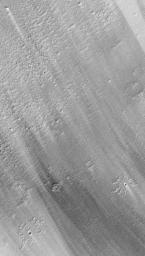
|
Pedestal Craters and Wind Streaks, South Medusae Fossae
- Click the image above for a larger view
- Full-Res JPEG (540 x 954) (84.2 kB)
- Full-Res TIFF (540 x 954) (458.7 kB)
Caption:
Mars is a desert planet in which wind has a considerable effect on the landscape. Bright and dark wind streaks in this image indicate past movement of fine sediment across the landscape from upper left toward lower right. Two impact craters that look like flowers or starfish are seen in the lower portion of the image. The ejecta deposits of these craters are raised above the surrounding terrain, and indicate that wind has deflated a layer of material (that is, blown it away, thus lowering the surface) that was present at the time that the craters formed. The craters were formed by impacts of meteorites into the earlier, higher surface, and the rocks and gravel thrown out when they formed protected some of this former layer from the wind's effects. This picture--showing part of the Medusae Fossae region near the martian equator--was taken in early April 1999 and covers an area only 1 kilometer (0.62 miles)wide. Illumination is from the lower right.
Background Info:
Malin Space Science Systems and the California Institute of Technology built the MOC using spare hardware from the Mars Observer mission. MSSS operates the camera from its facilities in San Diego, CA. The Jet Propulsion Laboratory's Mars Surveyor Operations Project operates the Mars Global Surveyor spacecraft with its industrial partner, Lockheed Martin Astronautics, from facilities in Pasadena, CA and Denver, CO.
Cataloging Keywords:
| Name | Value | Additional Values |
|---|---|---|
| Target | Mars | |
| System | ||
| Target Type | Planet | |
| Mission | Mars Global Surveyor (MGS) | |
| Instrument Host | Mars Global Surveyor | |
| Host Type | Orbiter | |
| Instrument | Mars Orbiter Camera (MOC) | |
| Detector | ||
| Extra Keywords | Crater, Dust, Grayscale, Impact | |
| Acquisition Date | ||
| Release Date | 2000-06-14 | |
| Date in Caption | ||
| Image Credit | NASA/JPL/MSSS | |
| Source | photojournal.jpl.nasa.gov/catalog/PIA01698 | |
| Identifier | PIA01698 | |
